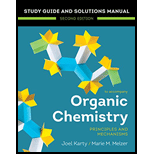
(a)
Interpretation:
The
Concept introduction:
The unimolecular elimination (
(b)
Interpretation:
The alkyl halide that can be used to produce the given compound in a
Concept introduction:
The unimolecular elimination (
Want to see the full answer?
Check out a sample textbook solution
Chapter 8 Solutions
EBK ORGANIC CHEMISTRY: PRINCIPLES AND M
- draw out mechanism (either E1 or E2) for this combined with CH3OH (arrows, intermediates, etc should be shown). Circle the less prevalent and more prevalent productsarrow_forwardDraw the major product for each of these reactions.arrow_forwardDraw the mechanism for the following transformation that shows the flow of electrons leading to the product. Show intermediates in the following mechanism. Please label clearly and answer correctly.arrow_forward
- For each set of reactions, circle the mechanism (SN2 vs SN1), draw the main organic substitution/elimination product (for each reaction draw the product, though in some cases it may be equivalent) and indicate which reaction occurs at the faster rate.arrow_forwardDraw the structure for the major reaction product for the following reactions. Draw out the mechanism.arrow_forwardDraw the curved arrow mechanism for the following transformation. Show the mechanism that leads to each product.arrow_forward
- Determine whether the following will proceed via SN1, SN2, E1 or E2 reaction. Draw the major product.arrow_forwardFor the following reaction, choose the most likely reaction pathway and draw the major product. Only draw the resulting organic species, omit counterions.arrow_forwardWhen a single compound contains both a nucleophile and a leaving group, an intramolecular reaction may occur. With this in mind, draw the product of the following reaction.arrow_forward
- (SYN) For each of these compounds, draw an alkyl (a) (b) halide that can be used to produce it in an E1 reaction. Then, draw the E1 mechanism that would take place when the alkyl halide is treated with water.arrow_forwardDraw the mechanism for this reaction. HO H,SO4.arrow_forwardDraw the product of this reaction. No mechanism is requiredarrow_forward
 Organic Chemistry: A Guided InquiryChemistryISBN:9780618974122Author:Andrei StraumanisPublisher:Cengage Learning
Organic Chemistry: A Guided InquiryChemistryISBN:9780618974122Author:Andrei StraumanisPublisher:Cengage Learning
